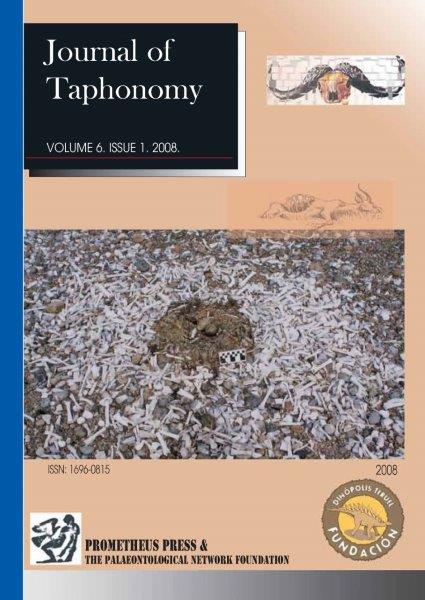


Jamie R. Wood, Trevor H. Worthy, Nicolas J. Rawlence, Susan M. Jones, Stephen E. Read.
Keywords: BONE, DEPOSITION, GIS, HOLOCENE, MIRING, MOA, NEW ZEALAND, WETLAND
Localised deposits of Late Pleistocene and Holocene bird bones occur in wetlands throughout New Zealand. These are characterised by dense accumulations of mostly disarticulated bones, with assemblages dominated by large, flightless bird taxa; in particular the extinct ratite moa (Aves: Dinornithiformes). A wide range of deposition mechanisms were historically proposed for these sites, including large floods and stampedes during wildfires. We outline a simple method for analysing the orientation and spatial distribution of bones within these deposits using GIS software, and apply this method to the interpretation of three such deposits from South Island, New Zealand. The results are consistent with non-catastrophic, periodic miring of individual moa. Long bones within these sites were preferentially orientated and subhorizontally inclined, indicating post-deposition disarticulation and movement of the bones within the sediment by sediment liquefaction and raking from the legs of mired birds, with a possible influence from water flow. Small, light skeletal elements were significantly under represented in the deposits. This may be due to post-mortem scavenging or weathering of vertebra and crania, 'pumping' to the surface of light, buoyant elements during liquefaction events, or crushing of these elements by subsequently mired birds.
Oscar Cambra-Moo, Ángela D. Buscalioni, Rafael Delgado-Buscalioni.
Keywords: BIRD, DECOMPOSITION, DECAY RATE, TAPHONOMY
We explored decay rate dynamics in the early decomposition process of Gallus gallus. Our initial hypothesis was that the variation of the mass decay rate is sensitive to the alterations experienced by the carcass during decomposition. In order to establish a framework for the different patterns of carcass alteration, a sample with successive ontogenetic stages (from embryo to adult), set in three environmental conditions (subaerial, burial, and water-submerged), was examined over an 18-day experimental period. Values of the average mass loss and decay rate, and a measure of the overall decomposition rate (
Fredrick Kyalo Manthi.
Keywords: KANAPOI, PLIOCENE, NORTH-WESTERN KENYA, MICROFAUNA, TAPHONOMY
A taxonomic and taphonomic study was carried out on two assemblages of microfauna from the Pliocene locality of Kanapoi in north-western Kenya, in order to understand the agent/s responsible for their accumulation and the taphonomic processes that have influenced the assemblages. The two sites, namely, Nzube's Mandible Site and the Bat Site have yielded microfaunal remains comprising largely rodents and bats. The fauna at Nzube's Mandible Site derives from the same site as the holotype mandible of Australopithecus anamensis and comprises largely murids, while that from the Bat Site consists largely bats. Characteristics of the assemblages such as the high representation of nearly all skeletal elements suggest that, although pre- and post-depositional processes caused damage to the faunal remains, overall the samples are a fairly true reflection of the original assemblages that accumulated at the sites. Further, the high representation of virtually all skeletal elements, the minimal degree of etching among the murid incisors, and the high faunal diversity, particularly at Nzube's Mandible Site, indicate that the two assemblages accumulated in situ by way of predation. Even though several predators may have been involved, the barn owl (Tyto alba) or the giant eagle owl (Bubo lacteus), are the most likely accumulators of the two assemblages.